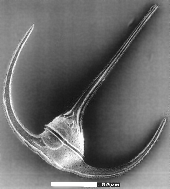








There are nearly 2000 known living species of dinoflagellates, classified in about 125 genera. Relationships of the Dinoflagellata to other protists are not well known. Part of the problem is that they have many unusual features. (Click on the Morphology button to see more.)
One real difficulty with the systematics is that dinoflagellates have traditionally been studied by both botanists and zoologists, and each of these fields has its own rules for names and nomenclature. A further complication has been the studies by palynologists, scientists who study spores and pollen, who use yet another system for naming the fossil species. Currently, the Dinoflagellata are treated under the rules of botanical nomenclature, since the last zoological treatment is many years out of date.
Classification within the group relies on the number and arrangement of thecal plates which make up the armor. Formulas based on the plates can be used to characterize many genera, though a genus may be variable for its particular formula. Plate arrangement has also been used to create hypotheses about the evolution of the group; those dinoflagellates with two major plates (Prorocentrales) are believed to be basal, and resemble the ancestors of the remaining orders.
Understanding about the origin of the photosynthetic dinoflagellates has recently come from the theory of endosymbiosis. According to this theory, all mitochondria and plastids originated as bacteria which were swallowed, but not digested. The bacteria became symbiotic with the organisms which swallowed them. This is the explanation now given for the double membrane around mitochondria and plastids -- the inner membrane is bacterial, and the outer membrane comes from the host.
In the dinoflagellates there is a triple membrane around the plastids and a small nucleus-like structure inside them, suggesting that this is a case of secondary endosymbiosis. The "plastid" is probably a swallowed diatom or chrysophyte, since it contains chlorophyll "c", and may contain fucoxanthin, both of which are otherwise found only in the Chromista. It is believed that this endosymbiosis event occured only once among the dinoflagellates, since the unusual yellow pigments peridinin and dinoxanthin are common among members of the group.
Current thinking in the phylogeny of protists places the dinoflagellates in the Alveolates, along with the Apicomplexa, Ciliata, and Foraminifera.


